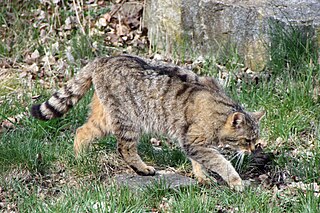
Felidae is a family of mammals in the order Carnivora, colloquially referred to as cats, and constitutes a clade. A member of this family is also called a felid. The term "cat" refers both to felids in general and specifically to the domestic cat.

The IUCN Red List of Threatened Species, founded in 1964, is the world's most comprehensive inventory of the global conservation status of biological species. It uses a set of criteria to evaluate the extinction risk of thousands of species and subspecies. These criteria are relevant to all species and all regions of the world. With its strong scientific base, the IUCN Red List is recognized as the most authoritative guide to the status of biological diversity. A series of Regional Red Lists are produced by countries or organizations, which assess the risk of extinction to species within a political management unit.

Felis is a genus of small and medium-sized cat Felinae species native to most of Africa and south of 60° latitude in Europe and Asia to Indochina. The genus includes the domestic cat. The smallest Felis species is the black-footed cat with a head and body length from 38 to 42 cm. The largest is the jungle cat with a head and body length from 62 to 76 cm.

Cercosaura is a genus of primarily South American lizards. The genus includes 16 species according to studies that transfer species from the two genera Pantodactylus and Prionodactylus to this genus.

Functional extinction is the extinction of a species or other taxon such that:
- It disappears from the fossil record, or historic reports of its existence cease;
- The reduced population no longer plays a significant role in ecosystem function; or
- The population is no longer viable. There are no individuals able to reproduce, or the small population of breeding individuals will not be able to sustain itself due to inbreeding depression and genetic drift, which leads to a loss of fitness.

The volcano shrew is a species of mammal in the family Soricidae found in the high-altitude rainforest of Burundi, eastern Democratic Republic of the Congo, Rwanda, and Uganda. Its natural habitats are subtropical or tropical moist montane forests and swamps. Its type locality is Rwanda, Parc National des Volcans, Karisoke.

Hubbard's sportive lemur, or the Zombitse sportive lemur, is a sportive lemur endemic to Madagascar. It has total length of about 51 to 59 cm, of which 23–25 cm (9.1–9.8 in) are tail. Hubbard's sportive lemur is found in southwestern Madagascar, living in dry transitional forests.Zombitse-Vohibasia National Park is the only protected area it is documented in. "This species is threatened by habitat loss and degradation from shifting agriculture, as well as unsustainable levels of hunting."

The World's 25 Most Endangered Primates is a list of highly endangered primate species selected and published by the International Union for Conservation of Nature Species Survival Commission Primate Specialist Group, the International Primatological Society (IPS), and Conservation International (CI). The 2012–2014 list added the Bristol Conservation and Science Foundation (BCSF) to the list of publishers. The IUCN/SSC PSG worked with CI to start the list in 2000, but in 2002, during the 19th Congress of the International Primatological Society, primatologists reviewed and debated the list, resulting in the 2002–2004 revision and the endorsement of the IPS. The publication has since been a joint project between the three conservation organizations and has been revised every two years following the biannual Congress of the IPS. Starting with the 2004–2006 report, the title changed to "Primates in Peril: The World's 25 Most Endangered Primates". That same year, the list began to provide information about each species, including their conservation status and the threats they face in the wild. The species text is written in collaboration with experts from the field, with 60 people contributing to the 2006–2008 report and 85 people contributing to the 2008–2010 report. The 2004–2006 and 2006–2008 reports were published in the IUCN/SSC PSG journal Primate Conservation, while the 2008–2010 and 2010-2012 report were published as independent publications by all three contributing organizations.
Cercosaura anordosquama is a species of lizard in the family Gymnophthalmidae. It is endemic to Brazil.
Cercosaura argulus, the elegant eyed lizard or white-lipped prionodactylus is a species of lizard in the family Gymnophthalmidae. It is found in Colombia, Ecuador, Bolivia, French Guiana, Peru, and Brazil.
Cercosaura doanae is a species of lizard in the family Gymnophthalmidae. It is endemic to Peru.
Cercosaura eigenmanni, Eigenmann's prionodactylus, is a species of lizard in the family Gymnophthalmidae. It is found in Bolivia, Brazil, and Peru.
Cercosaura manicata, the slender prionodactylus, is a species of lizard in the family Gymnophthalmidae. It is found in Ecuador, Peru, Bolivia, and Colombia.
Cercosaura nigroventris is a species of lizard in the family Gymnophthalmidae. It is endemic to Venezuela.
Cercosaura phelpsorum is a species of lizard in the family Gymnophthalmidae. It is endemic to Venezuela.
Cercosaura quadrilineata, the lined many-fingered teiid, is a species of lizard in the family Gymnophthalmidae. It is endemic to Brazil.
Cercosaura schreibersii, Schreibers's many-fingered teiid or long-tailed little lizard, is a species of lizard in the family Gymnophthalmidae. It is found in Argentina, Uruguay, Paraguay, Bolivia, and Brazil.
Cercosaura steyeri is a species of lizard in the family Gymnophthalmidae. It is endemic to Argentina.











